This review written Roman Selimov within .
It so happens that I am interested in cars. I try to maintain mine myself, and often end up with all sorts of decorations. Those who are familiar with this topic have come across the so-called “Jackie Chan” - a yellow check engine indicator on the dashboard of an iron horse, signaling an error in the operation of the engine or its systems.
In this situation, the owner has three options:
1. Contact a service station, where they will connect a serious scanner and tell you the reason for “Jackie Chan”, and then, if desired, they will eliminate it... perhaps.
2. Use the “paperclip” method and conduct self-diagnosis. The method is convenient, but here you will already need knowledge of the basics of interacting with a car, a manual for it, a garage... well, and a liter of unfiltered, as an option.
3. Conduct self-diagnosis, but using such a popular thing as wi-fi obd2 adapter ELM327.
Initially, such adapters were wired and intended for laptops. It is worth noting that they are still being produced to this day, because according to the reviews of experienced ones, they allow you to get more functions in applications for laptops, although these applications are already much stronger than those for iOS and Android.
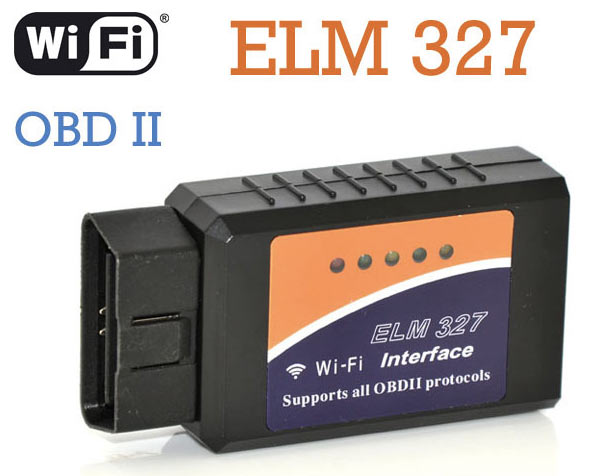
Next came Bluetooth adapters. Android phones are great friends with them, but the “Good Corporation” has limited the functionality of the “bluetooth” to trinkets with sound.
Therefore, having read on the site about a joint promotion with eBay, it was decided to order the version of the wi-fi adapter for testing in conjunction with my Toyota Vista 2002 (right-hand drive for the Japanese market) not only on an iPad, but also on an Android phone. So let's get started.
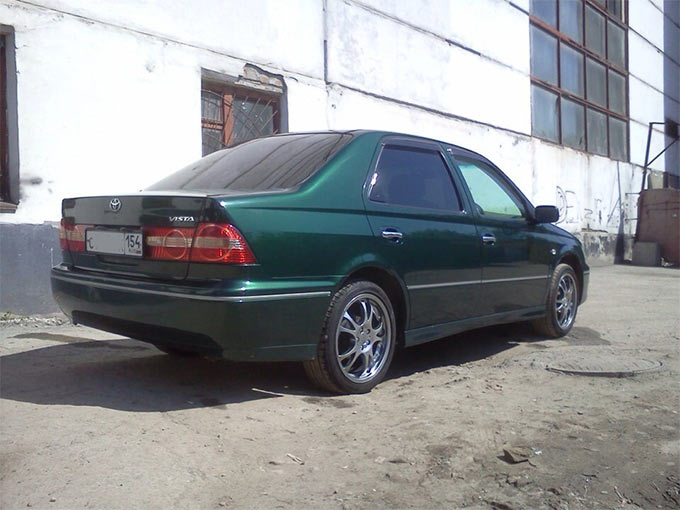
Connecting the device
It's quite simple. The adapter is inserted into the car's obd2 connector. Usually it is located under the instrument panel of the driver's seat, but sometimes it is also in the engine compartment. The connector is typically white and trapezoidal in shape. The adapter already works when the ignition key is in the “START” position, but at the same time it consumes enough energy, so it is better to carry out all manipulations with the engine running.
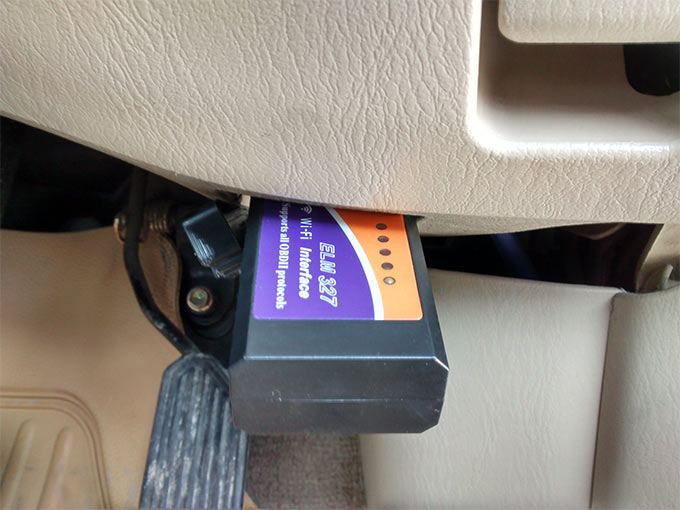
So, the adapter is in the connector, let's move on to the tablet.
Go to settings, wi-fi. The CLKDevices device should appear there. Click on it and connect automatically.

After this, click the blue arrow next to the device and edit the connection parameters:
1. Select the “static” tab and enter the IP address: 192.168.0.11 subnet mask: 255.255.255.0 router: 192.168.0.10
2. HTTP Proxy. The setting is unclear, since it is not saved in memory; after exiting the settings, it is reset accordingly. Well, let it be. Go to the “manual” tab and enter the numbers 35000 in the “port” field.
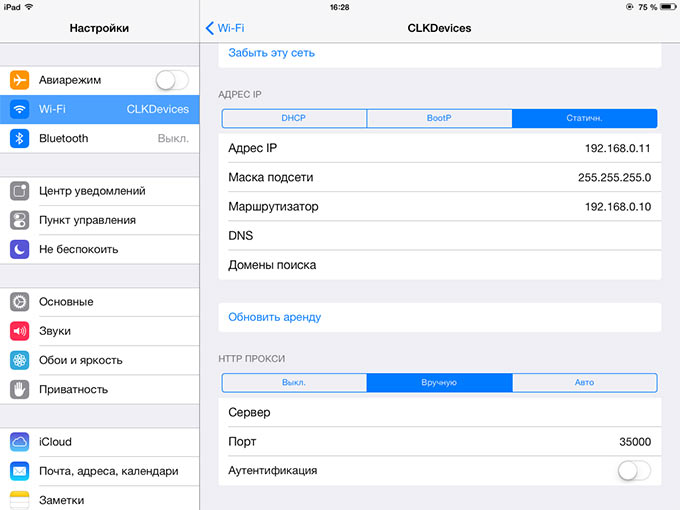
Now let's look at compatible software
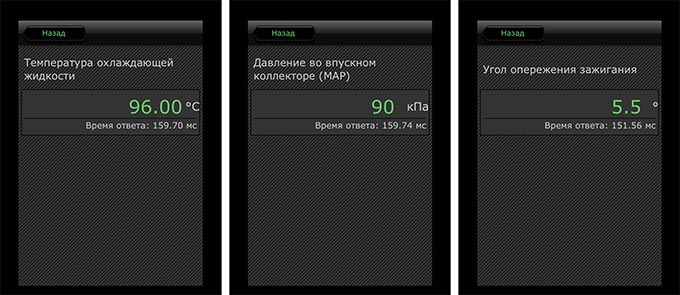
The program has a set of profiles, which is good, but with Toyota it fails again. Again, after reading topics on the Internet, I concluded that he is friends with European women. He is also friends with Koreans. For this purpose, a 2013 Ssang Yong Actyon was sampled. The program quickly connected to the car, the list of parameters is not very diverse, but all the basics are there. Developers from Kyiv promise to develop it.

The only application that showed at least something on Toyota. The voltage of the on-board circuit is important, but it is not enough.
![]()
It costs 327 rubles, it’s affordable, but I didn’t take it for one reason. This application It's cross-platform, so I tried it on an Android phone. This did not give any results on Toyota, although the program is very nicely drawn, do an in-dash installation and that’s it!

Ssang Yong Actyon 2013 was quickly connected, the program works, the parameters are shown. I even identified two ECUs: one for the engine, the second for the automatic transmission. this allows you to view parameters including automatic transmission. It’s a pity that we couldn’t connect with Toyota again.
Summarizing all that has been said, it becomes sad that programs from App Store turned out to be not particularly useful in our conditions, since the popularity of right-handed Toyotas beyond the Urals is obvious. With my friend’s car, the Ssang Yong Actyon 2013, things were certainly more fun, but the aftertaste remained!
Thus, if you have a European or Korean car, then the programs I described will benefit you, the adapter is functional.
If you have a right-hand drive car, then there is only one piece of advice: try to do it like me! For a holiday on my street, I used an Android phone with TorquePro and Hobdrive. I won’t describe them (I think the editors won’t understand, the site is about the other side of the force, but if you ask...), I’ll just say that the programs saw my car with a bang, read many parameters, error codes, etc. We can only hope that their developers will pay attention to the App Store.
Apple Hot News:
One fine day, while driving slowly, right on the move, my beauty said: “CHECK SYSTEM.” Recovering from the ultimatum of the statement, I plunged into thought. What happened, what was wrong, how could I offend her? Well, I couldn’t possibly upset her lately. Everything was fine with us, as always. Moreover, a week earlier I went to Kyiv and back, covering 800 km. True, I tore one tire, put a hernia on the other and bent the disc. And also, thanks to this hole, I found out where the emergency fuel shut-off button is located. After that I drove another 350 km, but without incident. All the way back I was thinking about how to continue driving on our low-profile roads (225x45xR17) and whether it was time to get a larger profile.
Is it really only now, a week later, that Honda started complaining about those couple of bumps? Unlikely, but possible. I went onto the lift and personally inspected everything from below. Everything is fine, thank God. What then? Weather? Yes, it was near zero that day. Not impressive. Nothing could even freeze. Meanwhile, CHECK SYSTEM on the dashboard is becoming more and more annoying. After googling, I found advice to reset the battery terminal. I didn’t dare for a long time because I didn’t know how I would behave head unit. I saw in the instructions that it can be blocked. Where to look for the unlock code - idk. But it worked out. The life-giving temporary blackout brought results - CHECK disappeared! Three cheers! A great weight off one's mind!
Alas, CHECK returned a couple of days later. Yes, the second removal of the terminal again temporarily removed it. But the feeling that he will soon return remains. And so it happened. Well, it’s clear that the problem cannot be solved with a battery. We need to go for diagnostics. And here I come across an assumption that gasoline may be to blame. Hmm, that’s for sure - I filled the tank full on that trip and am still driving on that gas! I refueled on the highway, at OKKO. I decide to roll it out to the bottom and refuel with the usual. While I was rolling out, CHECK came on again. I refueled at the good old gas station and while everything is OK, CHECK does not appear. As I continue to observe, there is a feeling that the experiment is not finished.
In the meantime, the thought couldn’t leave me that it would be nice to find out what was the reason for the appearance of CHECK. The inquisitive mind of an engineer does not tolerate uncertainty. I decided to clarify things using an OBD-II scanner. The choice stops at ELM327 as the only available option. Which interface to choose: USB, Bluetooth, WiFi? After some hesitation, I choose the WiFi interface as the most universal. Here you have support for Windows, iOS, and Android. No sooner said than done, bought.
There are many applications that work with ELM327. It was decided to start with Android and with the most popular app called Torque.
And now the solemn moment of the test - I plug the device into the OBD-II connector and look for a new access point in the smartphone (the manual has been previously re-read, the IP addresses and port are registered). Looking... Looking... Hmm, maybe I should come closer? I get into the car. I'm looking for an access point... But where is it? And here! Appeared. It's called WiFi_OBDII. I click "Connect". Oops, where did she go again? I was just there. I'm looking again... Waiting for it to appear... Waiting... There! I manage to connect, hurray! Before launching Torque, I decide to check the quality of the connection by myself. in a simple way- using ping. I launch ping and become despondent. Response times range from 500ms to 1500ms. The number of lost packages is crushing hope for normal work with the device into powder - 50%. It is quite obvious that the WiFi module is either acting up or not working at all. Ok, I decide to go to the device settings page via the web interface. I'll take a look, maybe I'll see something interesting. And indeed, I see that the device’s radio module operates on the first channel. It is quite possible that some other WiFi radio module is broadcasting on this channel (there is a residential high-rise building nearby, the number of access points does not fit on one screen Samsung Galaxy S4) and therefore it interferes with the weak Chinese signal. I install channel 6, press the reset button. I'm waiting for the WiFi_OBDII access point to appear. I am waiting…
After half an hour of waiting and trying to connect with different devices with WiFi comes the understanding that the connection with the scanner is most likely lost. Well, now nothing will stop me from disassembling the scanner. I'll see how it works. Maybe I'll see something interesting.

ELM327 WiFi disassembled
Here I bent the WiFi module board. I conducted an experiment - I touched the antenna mounted on the board and, lo and behold! The smartphone found the access point and easily established a connection with it. I launched ping - the response time was within normal limits, there were no lost packets at all. When I removed my finger, lost packets began to fall, and the response time increased sharply. The problem is obvious - a weak signal. The antenna on the board is completely ineffective. The solution is simple - you need to strengthen the antenna.
I soldered 10 cm long wires to the antenna wired on the board and ran ping again. The solution is effective - there are no lost packets, ping is 1-2 ms, which is very good
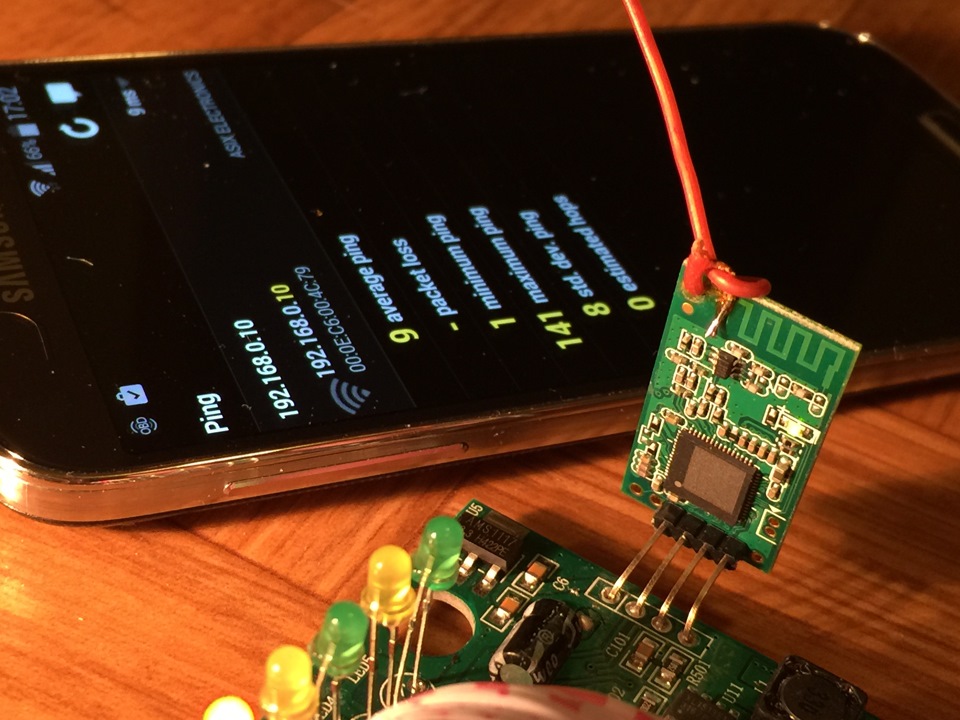
ELM327 WiFi with antenna
I'm putting everything back in the box. For a new antenna, I make a hole in the housing and bring it out
Greetings, Reno Logan car enthusiast! Today’s video is devoted to the following question: how to connect an ELM 327 Wi-Fi adapter to an Android smartphone.
This adapter is necessary to obtain data about the condition of the engine and any errors in its operation.
On Reno Logan cars, the OBD2 diagnostic connector is located on back wall glove box (for drivers - glove compartment). The connector is covered with a protective cover.
So. We open the glove compartment lid and gain access to the connector we are interested in. Take the ELM 327 adapter and insert it into the connector with the indicators facing up. If the adapter is inserted correctly, the indicator on the device will blink. The ignition is turned off.
Next, turn on the ignition and activate the smartphone (you can start the engine). After turning on the phone, go to the settings and turn on Wi-Fi, since in our case we have an ELM 327 Wi-Fi adapter. At the same time, if the adapter is made for Bluetooth, then this function must be activated.
I will describe all the steps in order when connecting the ELM 327 Wi-Fi adapter for the first time:
- Installing the ELM 327 Wi-Fi car diagnostic adapter into the OBD2 connector
- Place the key in the ignition and turn on the ignition (you can start the engine)
On your smartphone or tablet, go to settings wireless networks WiFi:
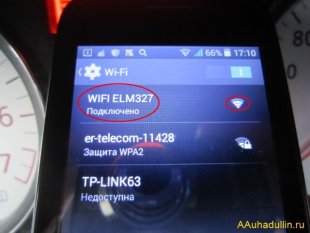
Choose WiFi network ELM327 (there may be a different name) and click on it.
- Next, go to the “additional” tab
- Select “IP settings” and then custom
Here in the tab we will enter the following data: IP address:
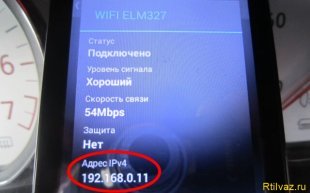
- 192.168.0.13 (the last 2 digits can be entered in any way, I guess this is the IP address of the smartphone/tablet)
- Gateway: 192.168.0.10 (nothing here, we don’t change this is the adapter’s IP address)
- Then click save
My ELM 327 adapter “found” my smartphone and connected automatically via Wi-Fi. The phone screen will display the connection, signal strength, data transfer speed and API address. After the first settings, the adapter will connect automatically for you too.
OBD car DOCTOR app
Launch the application and go to settings. Then click “connection”, select the mode Wi-Fi connections, then API address 192.168.0.10 (do not change the address value). 
If the address is not configured, it must be registered. The same address 192.168.0.10 is automatically registered when the adapter is connected for the first time via Wi-Fi.


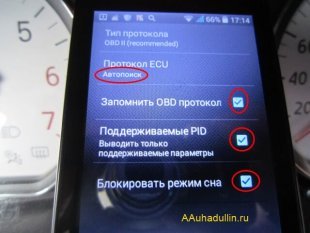
The application itself turns on. Select the function you need to control, for example, “dynamic parameters”, “flow”, “diagnostics” and so on.
In our case, the adapter immediately displayed an error in the “diagnostics” section: “misfire in the fourth cylinder.” Most likely, the spark plug in this cylinder is not working well. We need to fix it, the main thing is that we know what and how to fix the problem!
To exit the Car Doctor program, click on the “exit” symbol.
To practice controlling the program’s functions, I decided to take a second Android-based smartphone. I turn on the phone, go to the settings, turn on Wi-Fi and our ELM 327 adapter immediately “responded”.
Next we go to applications. I have two applications on this smartphone, the free “OBD Car Doctor” and the paid “OBD Car Doctor pro”, its cost today is 120 rubles. IN paid application a few more features.
To begin, let's go to free application and click “connect Wi-Fi”, and we see that the connection worked. We click on “OBD Car Doctor” and something in the form of a user manual is displayed.
Let's go into the application itself. There is a “log” section where you can save errors that appear for later correction and analysis.
If you send error data to the developer, you need to register to accumulate time between failures.
At the same time, the program provides data on the pressure in the intake manifold, the temperature of the surrounding fluid and other data on the engine.
When the “dynamic parameters” function is activated, the program provides data on voltage, engine speed, vehicle speed, fuel consumption and other parameters.
By consumption, you can, for example, look at: average, instant, total.
Scan Master application
Let’s also go to the “Scan Master” program, where you can also get a lot of data about the state of the engine systems. And also go to settings and activate the Wi-Fi function. In the “Scan Master” application, click “error codes”, “connect”. The screen displays the number of error codes – 1 (one).
This application also generated an error - “impaired operation of the fourth cylinder”, thereby confirming the correct operation of the diagnostic adapter.
When activating the “oxygen sensors” section, the program showed that there was no data. Most likely because the engine is not running and there is no combustion of the mixture.
Actually, for a simple car enthusiast, these simple programs are quite enough to perform routine diagnostics of the power plant and find its main faults.
If you purchase a paid version of the Scan Master application, then the program’s functions will be significantly expanded and available, including more motor parameters. Generally speaking, this is at the discretion of each car enthusiast and his needs for engine diagnostics.
For fun, find the “battery voltage” parameter. In our case, it shows a value of 11.7 V - it’s time to recharge after winter use of the car. You need to choose free time and go through all the functions of the programs so as not to get confused in the applications and know where to “dive” in the event of a malfunction.
After being in the glove compartment for a long time, the adapter did not respond to connection. It turned out that everything was simple, the contacts in the connector had oxidized and the connection was broken.
As always, the practical WD-40 cleaner for various purposes came to the rescue. I sprayed liquid on the contacts, let it dry, inserted the adapter into the diagnostic connector and everything worked.
That's all. Leave your comments, ask questions and like.
